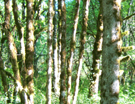Tree Farms Are Not Forests
Warning: this essay shifts a paradigm. Please remain seated while reading, to avoid injuries from fainting.
Ready? Here it is: tree farms are not forests and forests are not tree farms. The Old Paradigm holds that they are the same thing. The New Paradigm, presented herein, says they are completely and utterly different land uses. Well, maybe not utterly. Tree farms and forests both have trees. Other than that, the differences are starkly obvious and fundamental. Understanding the differences will benefit you, whether you are pro-tree farms, pro-forests, or pro-both, like me.
How are tree farms and forests different? Let us count the ways. First, they are structurally different. By “structure” I mean the three- dimensional, above-ground lattice: the stems, branches and leaves that constitute the architectural framework.
On tree farm plantations the trees are all the same age, down to the week or day of planting. They are evenly spaced. As they grow, all the trees have similar heights, crown shapes, crown lengths, and stem diameters. Structure is homogeneous.
In forests the trees are never the same age. Even in so-called “even- aged” forests, stem recruitment actually lasts for many decades following stand replacement disturbance. In forests the trees are never evenly spaced. As differently aged and spaced trees grow, they diversify into unequal heights, crown shapes, crown lengths, and stem diameters. Structure in forests is heterogeneous horizontally and vertically.
Second, tree farms and forests are different biologically. Tree farm stands have only a few tree species, sometimes only one. Very few other plant species occur, especially under the dense canopies of fully- stocked plantations. Nor do many wildlife species find preferred habitat on tree farms, because of the structural and biological limitations.
Conversely forests contain many tree, shrub, and herbaceous plant species. I have surveyed vegetation in forest tracts that had over a dozen conifer species and hundreds of other kinds of plants, as well. So too hundreds of wildlife species, including rare and endangered ones, find their preferred habitat in forests. Northern spotted owls, for instance, select forests with heterogeneous structure and diverse prey, which they prefer over structurally and biologically limited tree farms.
Third, tree farms and forests are different ecologically. On tree farms the beginning and end of trees’ lives are determined by the tree farmer. The tree farmer decides when to plant, when to prune, when to thin, and when to harvest.
Forests change through natural stand dynamics, succession, and floristics. The development of our forests since the Ice Ages is a fascinating study. Human beings have been living here all that time, and people have and enormous impact and effect on “natural” forests. It is not 100 percent correct to call our forests “natural”; “mostly natural but certainly human mediated” is better. Regardless, forests are much more complex ecologically than tree farms.
Fourth, and most important, tree farms and forests have different purposes. People use tree farms and forests differently. Tree farms are agricultural businesses. Tree farmers plant, tend, and harvest trees to be sold, for money. Hopefully at a profit, too. Tree farms are like corn farms, wheat farms, or any other kind of farm.
Forests are nature preserves used for camping, hiking, wildlife habitat, nature studies, and other non-commodity applications. Forests cost money to own; they are a luxury.
Fifth, tree farms and forests are managed differently. It stands to reason that since tree farms and forests are not the same structurally, biologically, ecologically, or in their uses, their management practices are not the same, either. Silviculture, even-age management, uneven- age management, group selection, and single tree selection are all tree farm management practices. All are oriented towards harvest of trees as commercial products. Site prep, tree planting, pruning, thinning, and harvesting are agri-business treatments designed to maximize profits from crops.
Forests are (or should be) managed to protect, maintain, and perpetuate natural ecosystems. Pacific Northwest forests are at risk from fire. Our forests need fire access roads, fire ponds, pumping stations, constant vigilance, and rapid response to fire outbreaks. They need fuels management to increase resiliency to fires. And our forests need to be restored after devastating fires.
Tree farms are not forests, and forests are not tree farms. Both are great land uses, but not on the same acres. Corn farms and wetlands are both fine, but not in the same place. Wheat farms and native prairies are both wonderful, but you cannot growth both on the same spot. So too with tree farms and forests.
I love forests. I have been a professional forester for 30 years. I also love tree farms, and have been a professional tree farmer for the same 30 years. That’s why I know so much about both, and to me the differences between tree farms and forests are so clear and obvious.
